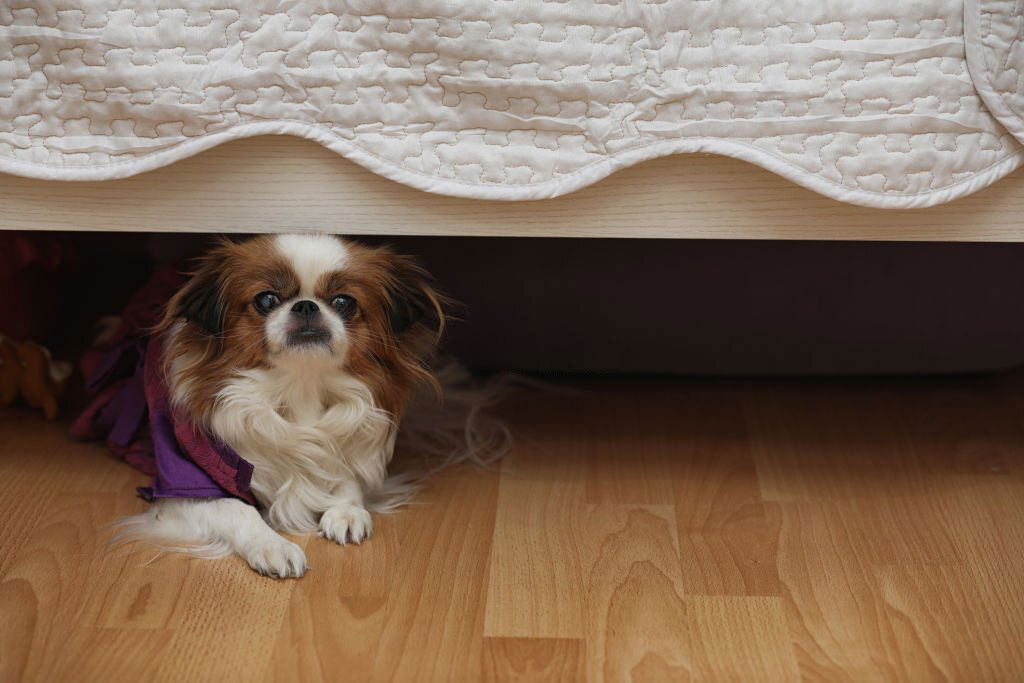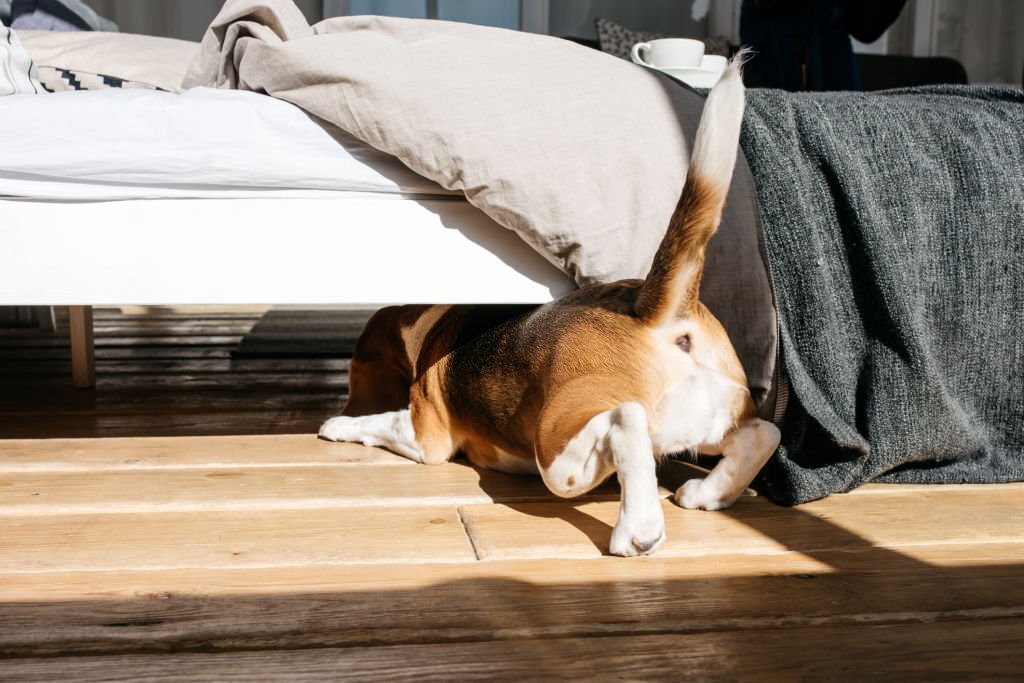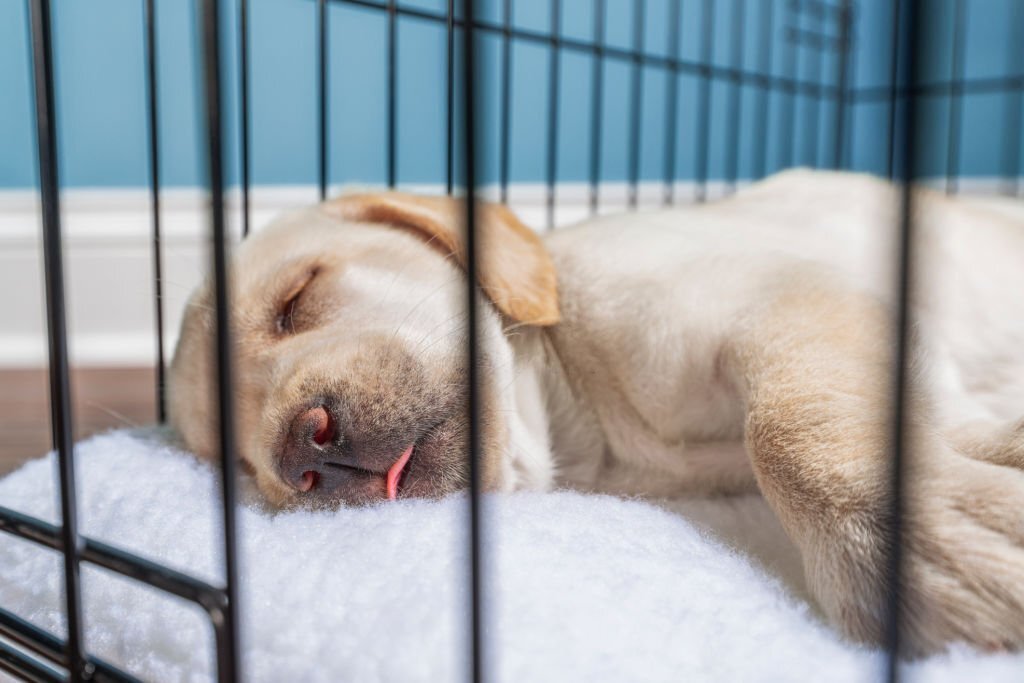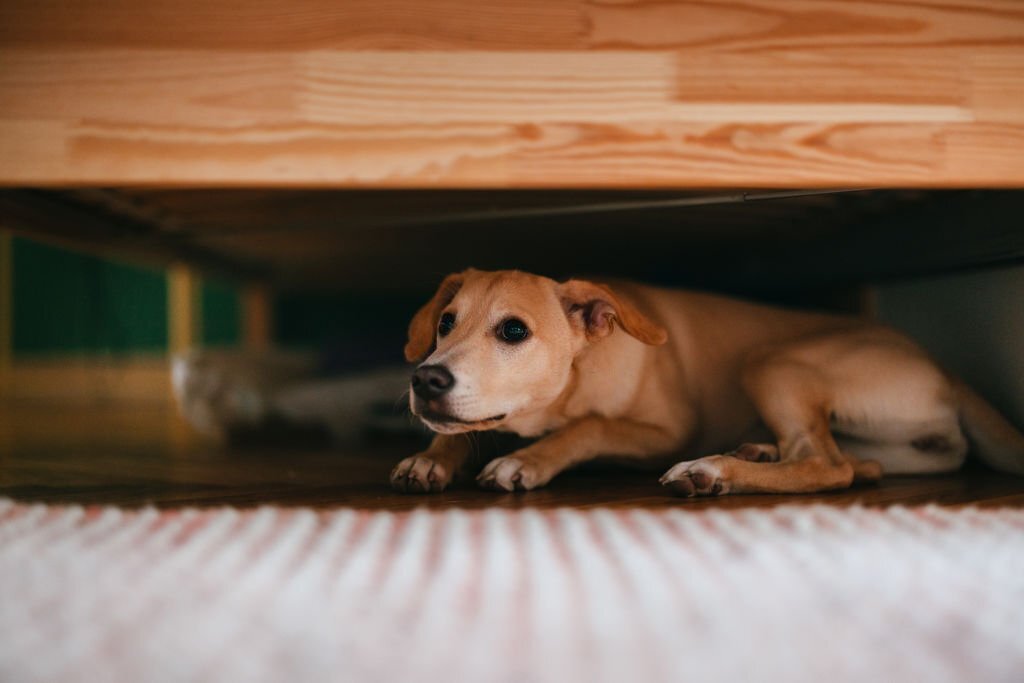We're an affiliate
We hope you love the products we recommend! Just so you know, we may collect a share of sales or other compensation from the links on this page at no additional cost to you. Thank you if you use our links, we really appreciate it!
Some dog owners are often left baffled by their dog’s choice to sleep in strange places.
Well, some dogs have formed the habit of retreating into the darkest spot beneath their owner’s bed for several motives.
Is your beloved canine friend trying to avoid you? Or, are they simply looking for a private area to calm down?
There are several reasons why your dog is sleeping under your bed, ranging from instinctual behavior to more concerning reasons.
Keep reading this post to discover the common reasons for this behavior and watch out for our practical guide on how you can solve the problem.
Dog’s Sleeping Pattern
Healthy adult dogs can sleep for an average of 12 to 14 hours in short sessions over a single day.
This duration is influenced by several factors including breed, age, diet, personality, activity level, health condition, and the sleeping surface.
Puppies and senior dogs may need more sleeping time (18 to 20 hours) in a single day compared to adult dogs.
Unlike humans, dogs are polyphasic sleepers – meaning they can sleep in multiple sessions a day spanning both day and night.
The sleeping periods in dogs can range from quick naps after mealtime, to deep sleep at night, or a brief nap under your bed.
Dogs can have different sleeping positions depending on the weather conditions, the personality of the dog, and the sleeping surface.
The following are some of the most common sleeping positions for dogs:
- Back-to-back sleeping for multiple dogs
- Burrowing
- Cuddling
- Pawing and nesting
- Raised head and neck
- Sleeping on sold surfaces e.g., on the floor
- Sleeping on the sides
- Sleeping on their back (the belly-up position)
- Sprawling out position
- The donut position
- The lion’s pose
Sleeping Behavior in Dogs
Preparing for naptime can be a huge business for most dogs. It’s common for them to engage in different sleeping behaviors, both verbal and nonverbal, before winking and when sleeping.
Your dog’s sleeping behavior can give you valuable insights into their sleep quality and their health conditions.
The following are some of the common sleeping behaviors in dogs:
- Barking and squeaking
- Circling before sleep
- Digging before sleep
- Dreaming (during REM sleep)
- Seizure
- Snoring
- Twitching while sleeping
Why Does My Dog Sleep Under My Bed
1. It’s safe for them
Dogs desire safety as much as we do. Your furry friend might dash beneath the bed to seek solace during a strong thunderstorm or fireworks.
The bottom space of your bed is well secured, and this gives your pup a sense of security. This also explains why most dogs prefer retreating to their crates during stressful situations.
Your bedroom is also a silent place with less foot traffic, and this makes your dog feel secure while hiding under the bed.
2. Your dog wants privacy
Dogs are social animals, but sometimes they need a moment of solitude in a personal space. One of the best places for dogs to escape is right beneath your bed.
If you live in a household with multiple active pets and playful kids, then your dog may change spots and move below the bed in search of privacy to enjoy some quietness.

Most dogs are always in a continuous search for a permanent retreating place for comfort and relief. The space under a bed is more permanent, unlike the table or chair, which may be moved regularly.
Furthermore, your furry friend could dash below your bed in an attempt to hide from a visitor or another pet.
They may have had an accident on your carpet and the only place to hide from the mess is under your bed.
3. They’re hiding something
It’s natural for dogs to hide leftover foods and their favorite toys in hidden spots. Your furry friend must have discovered a favorite corner under your bed where they can safely hide a few treasures.
One of the major reasons why your dog may choose to keep his belongings under the bed is because no one seems to ever interfere with the place.
If your dog has the habit of hiding treats, foods, toys, and several treasures in hidden spots, you shouldn’t be worried because this is an instinctive canine character.
4. For stress and anxiety relief
Emotional distress and anxiety are some of the reasons why your dog may decide to lounge under your bed.
A dog prone to separation anxiety may feel overwhelmed when the owner leaves the house, making them seek other means of comfort.
The bedroom area is probably filled with your smell and your lovely pup feels consoled when they go beneath the bed to get your scent.
Changes in the day-to-day activities of the dog may also drive them into stress and make them seek relief in secluded areas.
Bringing a newborn baby home could make your furry friend feel ignored. Having several visitors at a go may also be overstimulating for your pup due to the immense attention from the new faces.
Hiding and sleeping under the bed can be a telltale sign that your dog is trying to relieve emotional distress from new activities around the house.
5. They want some cold
Unlike humans who can sweat, dogs have a limited way of regulating body temperature. They cannot sweat through their skin (they only have tiny sweat glands on the paws and nose).
Dogs are furry animals, covered with a fluffy coat that crowns their beauty. But this layer of fur may retain lots of body heat during hot months making the dog feel uncomfortable.
It’s for this reason that most dogs will prefer sleeping on the cold tiled floor during warmer months to dissipate their body heat.
During the summertime, you will certainly notice your dog’s love for the floor. Your furry friend may prefer rolling on the tiles as a way of keeping the body cool.
As the summertime approaches, you need to have safe alternatives on how you can keep your dog cool during the heat wave.
Ensure your dog stays hydrated by providing plenty of water, taking them swimming, creating a shaded spot outside, giving them frozen treats, and investing in a cooling bed for maximum airflow.
6. They’re not feeling well
Do not rule out the possibility of medical conditions as the reason for your dog’s choice to sleep under the bed.
A dog experiencing pain and discomfort from physical illness may withdraw from their everyday family interactions to seek a quiet place for relief.
This makes them get less engaged in their surrounding and they may go to the darkest spot under the bed.
If your furry friend has suddenly picked up this behavior of hiding under the bed, you should take a closer look for any signs of illness.

Other signs to watch out for include being scared, anxious, excessive drooling, whining, barking, lethargic, excessive barking, pacing, or any other unwanted sign.
Reach out to your vet as soon as possible, once you suspect illness is the primary cause for your dog’s dalliance with the bed’s underside.
7. It’s a sleeping behavior
Dogs are creatures of habit and they tend to form character based on what they’re taught. Your dog may have developed the habit of sleeping under the bed because they found it soothing and rewarding.
You may have unknowingly reinforced the behavior by rewarding them when they took cover under the bed.
It helps to redirect your dog when they sleep in inappropriate areas. Let them know how soothing it is to sleep in designated spots for their safety and comfort.
Should I Let My Dog Sleep Under the Bed?
There’s no harm in allowing your dog to retreat under the bed once in a while especially when they want comfort, security, and privacy.
But, if your dog is suddenly sleeping under the bed for extended periods, you should try to find the reason(s) for this behavior.
Hiding in small spaces is one way your furry friend may use to escape from the daily bustles of everyday life.
If they do this due to natural instincts or cooling during the summer, then there’s really not much to worry about.
But if the behavior is driven by more serious reasons such as illness or emotional distress, you need to work out a solution immediately.
When Does It Become a Problem?
For the most part, it is normal for dogs to dash beneath the bed for mild reasons such as comfort and security.
But when does this habit become a problem?
When your dog suddenly changes their behavior to pick up the new sleeping habits, then this should be a cause for alarm.

It’s also a clear sign of underlying issues when your dog spends too much time beneath the bed. This shows that they now prefer staying lonely to interacting with their human family.
Excessive stay under the bed is also a sign of fear, anxiety, or potential underlying health problems.
If you suspect that your dog’s habit of sleeping under the bed is becoming a concern, then it’s important to inform your vet as early as possible.
How To Keep My Dog from Sleeping Under My Bed
If you’re worried about your dog’s decision to sleep under the bed, there are a few things you can do to discourage this behavior.
Here are the best options for you:
1. Create a comfortable sleeping area
What if your dog is going beneath the bed because they don’t have a comfy sleeping area? Start by creating a convenient sleeping surface for your dog.
Invest in a high-quality dog bed, appropriate for your dog’s size, and furnish it with enough bedding for added comfort.
For dogs advancing in years, you can consider getting them an orthopedic dog bed to offer more support on the pressure points.
Crate the dog’s bed and place it in a quiet, well-lit, and well-ventilated room away from frequent human foot traffic.
The room should be easily accessed by any member of the household and it should be spacious enough to accommodate your dog and a few accessories.
You can entice your dog to spend time in their designated room by furnishing it with accessories such as interactive toys, water bowls, food bowls, and burrowing spots.
2. Train your dog to sleep in their area
After providing a comfortable space for your dog to sleep, you need to encourage them to spend time and sleep in their designated spots.
Redirect your dog to their room during bedtime and reward them with high-value treats for sleeping on their spots.
You can also create a pre-bedtime routine by minimizing activity when the sleeping hour approaches and petting your furry friend before retiring them to bed.
Positive reinforcement training will help your dog create a positive association with their sleeping area and this will enable them to return to the area every time they need a rest.
It may take a while to redirect your lovely dog from their favorite spot ‘under the bed’ to their new room. Remember to be consistent and patient with training.

Avoid punishing your dog by forcefully removing them from the bed’s underside. Scolding your furry friend for sleeping in a comfy spot may create a negative association and make the problem worse.
3. Visit the vet
On realizing that your dog is hiding and sleeping under the bed because of medical problems, you should speak with your vet immediately.
A well-trained practicing vet will be able to identify the possible physical injuries, emotional distress, or illness that make your dog seek personal space under the bed.
Your vet will carry out a physical examination and medical tests to rule out any medical problems and redirect you to an animal behaviorist if the problem is psychological.
4. Desensitization training to relieve anxiety
If your dog runs beneath the bed because of psychological reasons, then you need to desensitize them to the triggers.
Your first assignment should be to identify the anxiety triggers before developing a convenient solution.
The most common triggers for anxiety include neglect, changes in day-to-day activities, the arrival of a newborn baby, and loud noises such as thunderstorms.
Once you have identified the exact causes for your dog’s fear, you should desensitize them with repeated exposure in a controlled environment.
It’s important to start with low doses of exposure and monitor your dog’s reaction with progress. Reward your dog and pet them gently every time they overcome their fear.
For example, if you’re dealing with noise phobia during winter, you can play a recording of thunderstorm noises at minimal volume to your dog in a soundproof area.
If the desensitization process seems a little difficult for you, feel free to engage the services of a professional dog trainer.
Frequently Asked Questions (FAQs)
1. Can sleeping under the bed be harmful to my dog’s health?
In many situations, it is perfectly fine for dogs to sleep under the bed. This will also depend on the type of flooring surface in your bedroom.
Sleeping on a cold tiled surface during the winter may cause too much cold and increase the chances of the dog becoming ill.
The hard surface beneath the bed is also not convenient for elderly dogs because of their weakening joints. The cold surface may also make the problem worse for dogs suffering hip problems.
2. How do I encourage my dog to sleep in a different spot?
First of all, you need to know the reasons why your dog prefers to sleep beneath the bed and identify the solution to solve the problem.
To encourage your dog to sleep in a different spot, you need to make the alternative spot very inviting and comfortable.
Invest in a good quality dog bed and furnish it with enough bedding for added comfort.
Reward your dog every time they sleep on their bed to encourage the behavior and create positive associations.
3. Is it normal for dogs to change their preferred sleeping location?
Yes! Dogs may change their preferred sleeping location while searching for a more comfortable, private, and secure place.
Other factors that make dogs switch sleeping spots include temperature regulation, health conditions, and psychological reasons.
4. What should I do if my dog starts sleeping under the bed suddenly?
Check for signs of anxiety, stress, or fear. You should also examine their body for signs of pain or physical illness such as injuries and wounds.
Make a call to your vet If you suspect any underlying condition.
It may also help to inspect the bottom area of your bed since your dog may have found a suitable spot to hide treats and toys.
Conclusion
Dogs love comfort, privacy, and security. The darkest spot beneath your bed might be what they’re looking for to be happy.
Sometimes dogs may rush under the bed as a way of escaping attention from visitors or hiding from anxiety triggers such as loud noises.
It is also possible that your dog may be creating a personal space under the bed because they’re in pain and want to stay away from their human family.
If your dog is suddenly moving under the bed to retreat and sleep, you need to be cautious and identify the possible reasons for this behavior.
You should consider creating a comfortable place for your dog to sleep and take them to the vet if you suspect any unusual activity.
Laura is the founder of Furs'n'Paws. She is a also a pet writer and expert with more than 20 years of experience of working with dogs and cats. She developed a very strong love for animals at a young age. Her passion led her to establish a thriving pet sitting and dog walking business in Dubai. As an expert in pet training, behavior, and nutrition, Laura is committed to helping pet owners and pet lovers by offering high-quality information on a wide range of topics.



No responses yet